Metabolic Study of Tetra-PEG-Based Hydrogel after Pelvic Implantation in Rats
Abstract
:1. Introduction
2. Results and Discussion
2.1. Properties of Hydrogels
2.2. Rate of Radioactivity Excretion in Urine and Feces
2.3. Radioactivity Recovery in Blood
2.4. Tissue Distribution
2.5. In Vivo Metabolite Analysis
3. Materials and Methods
3.1. Materials
3.2. Preparation and Detection of Hydrogel
3.2.1. Definition of the Gelation Time
3.2.2. Definition of the Swelling Ratio
3.2.3. Detection of Degradation Time
3.2.4. Calibration of the Radioactivity of 3H and 14C
3.3. Animal Grouping and Implantation of the Hydrogel
3.4. Collection and Analysis of Urine and Fecal Samples
3.5. Collection and Analysis of Blood Samples
3.6. Collection and Analysis of Tissue Samples
3.7. Statistical Analyses
4. Conclusions
Supplementary Materials
Author Contributions
Funding
Institutional Review Board Statement
Informed Consent Statement
Data Availability Statement
Conflicts of Interest
Sample Availability
References
- Slaughter, B.V.; Khurshid, S.S.; Fisher, O.Z.; Khademhosseini, A.; Peppas, N.A. Hydrogels in Regenerative Medicine. Adv. Mater. 2009, 21, 3307–3329. [Google Scholar] [CrossRef]
- Peppas, N.A.; Bures, P.; Leobandung, W.; Ichikawa, H. Hydrogels in pharmaceutical formulations. Eur. J. Pharm. Biopharm. 2000, 50, 27–46. [Google Scholar] [CrossRef]
- Mayr, J.; Saldias, C.; Diaz Diaz, D. Release of small bioactive molecules from physical gels. Chem. Soc. Rev. 2018, 47, 1484–1515. [Google Scholar] [CrossRef] [PubMed]
- Sokolovskaya, E.; Barner, L.; Bräse, S.; Lahann, J. Synthesis and on-demand delation of multifunctional poly (ethylene glycol)-based polymers. Macromol. Rapid Commun. 2014, 35, 780–786. [Google Scholar] [CrossRef] [PubMed]
- Li, J.; Mooney, D.J. Designing hydrogels for controlled drug delivery. Nat. Rev. Mater. 2016, 1, 16071. [Google Scholar] [CrossRef]
- Olthof, P.B.; Rassam, F.; Gulik, T.M. The use of a NHS-PEG coated, collagen-based sealant in a patient undergoing Associating Liver Partition and Portal vein Ligation for Staged hepatectomy (ALPPS). Int. J. Surg. Case Rep. 2018, 47, 7–10. [Google Scholar] [CrossRef]
- Lewis, K.M.; Ikeme, S.; Olubunmi, T.; Kuntze, C.E. Clinical effectiveness and versatility of a sealing hemostatic patch (HEMOPATCH) in multiple surgical specialties. Expert Rev. Med. Devices 2018, 15, 367–376. [Google Scholar] [CrossRef]
- Okabayashi, K.; Ashrafian, H.; Zacharakis, E.; Hasegawa, H.; Kitagawa, Y.; Athanasiou, T.; Darzi, A. Adhesions after abdominal surgery: A systematic review of the incidence, distribution and severity. Surg. Today 2014, 44, 405–420. [Google Scholar] [CrossRef]
- Spotnitz, W.; Burks, S. Hemostats, sealants, and adhesives III: A new update as well as cost and regulatory considerations for components of the surgical toolbox. Transfusion 2012, 52, 2243–2255. [Google Scholar] [CrossRef]
- Murdock, M.H.; Chang, J.T.; Luketich, S.K.; Pedersen, D.; Hussey, G.S.; D’Amore, A.; Badylak, S.F. Cytocompatibility and mechanical properties of surgical sealants for cardiovascular applications. J. Thorac. Cardiovasc. Surg. 2019, 157, 176–183. [Google Scholar] [CrossRef]
- Wallace, D.G.; Cruise, G.M.; Rhee, W.M.; Schroeder, J.A.; Prior, J.J.; Ju, J.; Maroney, M.; Duronio, J.; Ngo, M.H.; Estridge, T.; et al. A tissue sealant based on reactive multifunctional polyethylene glycol. J. Biomed. Mater. Res. 2001, 58, 545–555. [Google Scholar] [CrossRef] [PubMed]
- Konieczynska, M.D.; Villa-Camacho, J.C.; Ghobril, C.; Perez-Viloria, M.; Tevis, K.M.; Blessing, W.A.; Nazarian, A.; Rodriguez, E.K.; Grinstaff., M.W. On-Demand Dissolution of a Dendritic Hydrogel-based Dressing for Second-Degree Burn Wounds through Thiol-Thioester Exchange Reaction. Angew. Chem. Int. Ed. 2016, 55, 9984–9987. [Google Scholar] [CrossRef] [PubMed]
- Bu, Y.; Zhang, L.; Sun, G.; Sun, F.; Liu, J.; Yang, F.; Tang, P.; Wu, D. Tetra-PEG Based Hydrogel Sealants for In Vivo Visceral Hemostasis. Adv. Mater. 2019, 31, e1901580. [Google Scholar] [CrossRef]
- Tan, J.; Foster, L.J.R.; Watson, S.L. Corneal Sealants in Clinical Use: A Systematic Review. Curr. Eye Res. 2020, 45, 1025–1030. [Google Scholar] [CrossRef]
- Dunn, R.; Lyman, M.D.; Edelman, P.G.; Campbell, P.K. Evaluation of the SprayGel adhesion barrier in the rat cecum abrasion and rabbit uterine horn adhesion models. Fertil. Steril. 2001, 75, 411–416. [Google Scholar] [CrossRef]
- Mettler, L.; Audebert, A.; Lehmann-Willenbrock, E.; Jacobs, V.R.; Schive, K. New adhesion prevention concept in gynecological surgery. J. Soc. Laparoendosc. Surg. 2003, 7, 207–209. [Google Scholar]
- Herold, D.A.; Keil, K.; Bruns, D.E. Oxidation of polyethylene glycols by alcohol dehydrogenase. Biochem. Pharmacol. 1989, 38, 73–76. [Google Scholar] [CrossRef]
- Johnson, A.J.; Karpatkin, M.H.; Newman, J. Clinical investigation of intermediate- and high-purity antihaemophilic factor (factor VIII) concentrates. Br. J. Haematol. 1971, 21, 21–41. [Google Scholar] [CrossRef]
- Shaffer, C.B.; Critchfield, F.H.; Carpenter, C.P. Renal excretion and volume distribution of some polyethylene glycols in the dog. Am. J. Physiol. Content 1948, 152, 93–99. [Google Scholar] [CrossRef]
- Salvati, A.; So1derman, O.; Lynch, I. Plum-Pudding Gels as a Platform for Drug Delivery: Understanding the Effects of the Different Components on the Diffusion Behavior of Solutes. J. Phys. Chem. B 2007, 111, 7367–7376. [Google Scholar] [CrossRef]
- Unuofin, J.O.; Otunola, G.A.; Afolayan, A.J. Evaluation of acute and subacute toxicity of whole-plant aqueous extract of Vernonia mespilifolia Less. in Wistar rats. J. Integr. Med. 2018, 16, 335–341. [Google Scholar] [CrossRef] [PubMed]
- Li, N.; Zhang, Q.B.; Song, J.M. Toxicological evaluation of fucoidan extracted from Laminaria japonica in Wistar rats. Food Chem. Toxicol. 2015, 43, 421–426. [Google Scholar] [CrossRef] [PubMed]
- Ahmad, S.; Manzoor, K.; Purwar, R.; Ikram, S. Morphological and Swelling Potential Evaluation of Moringa oleifera Gum/Poly(vinyl alcohol) Hydrogels as a Superabsorbent. ACS Omega 2020, 29, 17955–17961. [Google Scholar] [CrossRef] [PubMed]
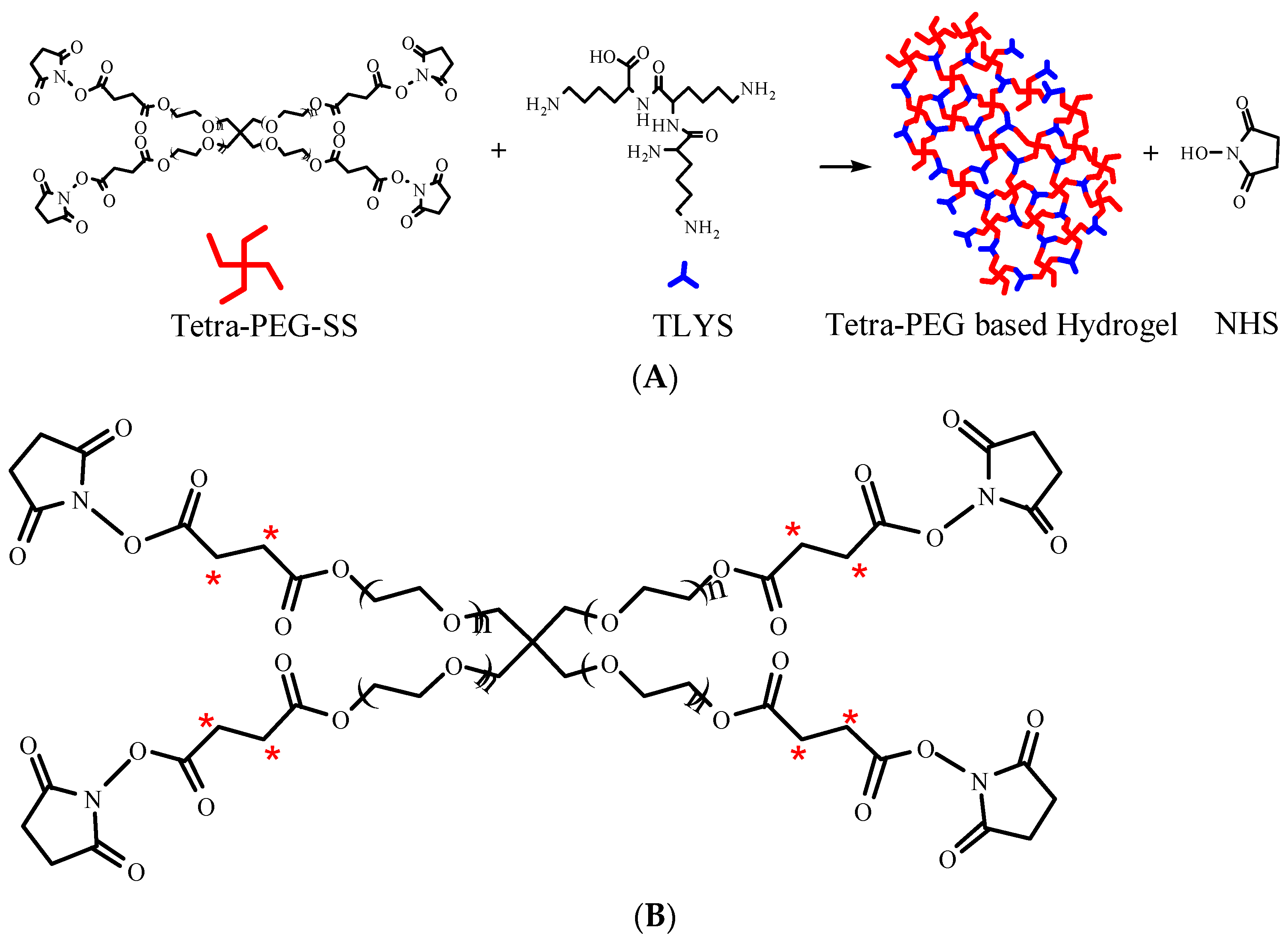

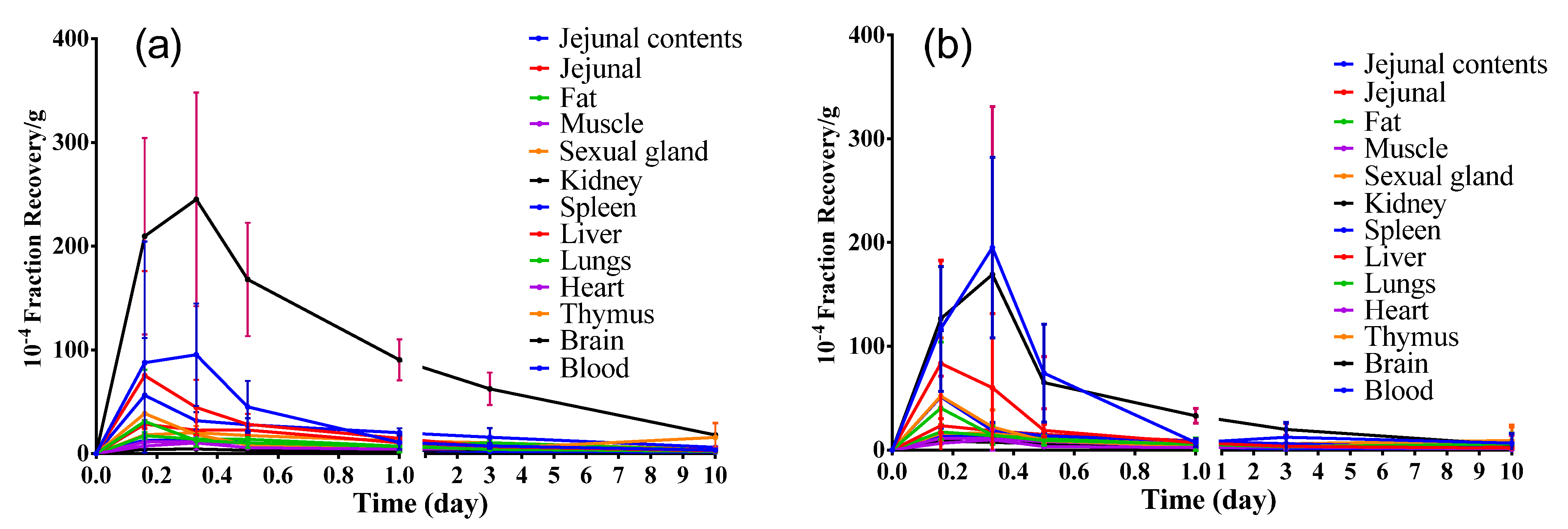
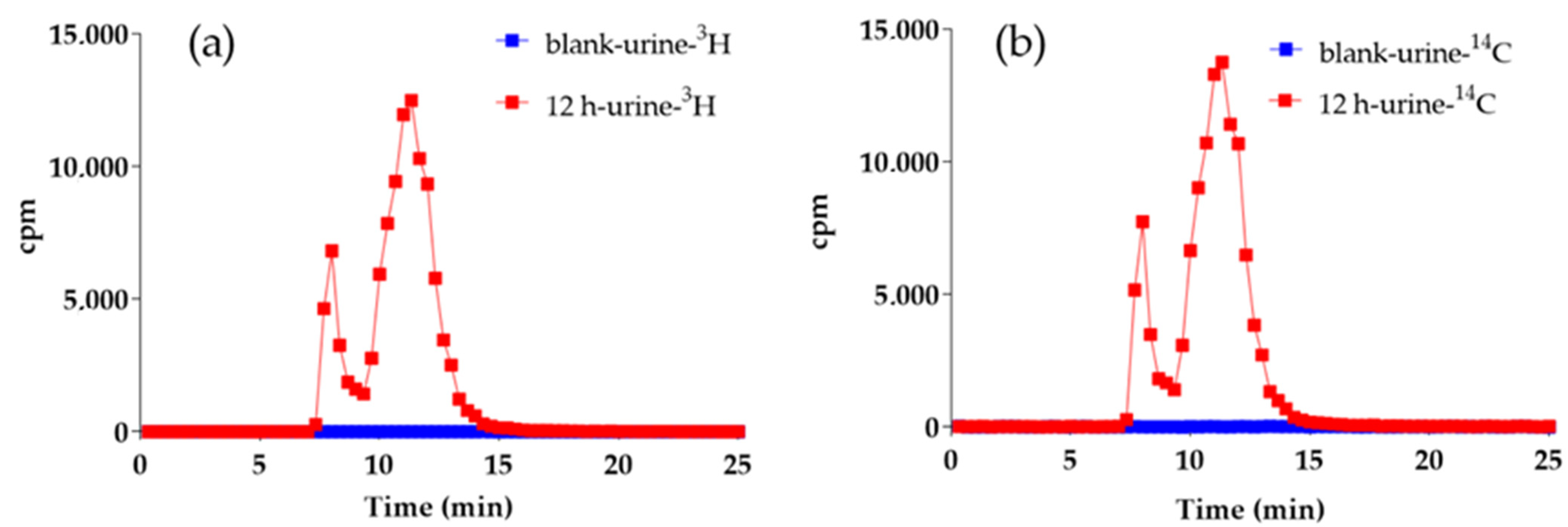


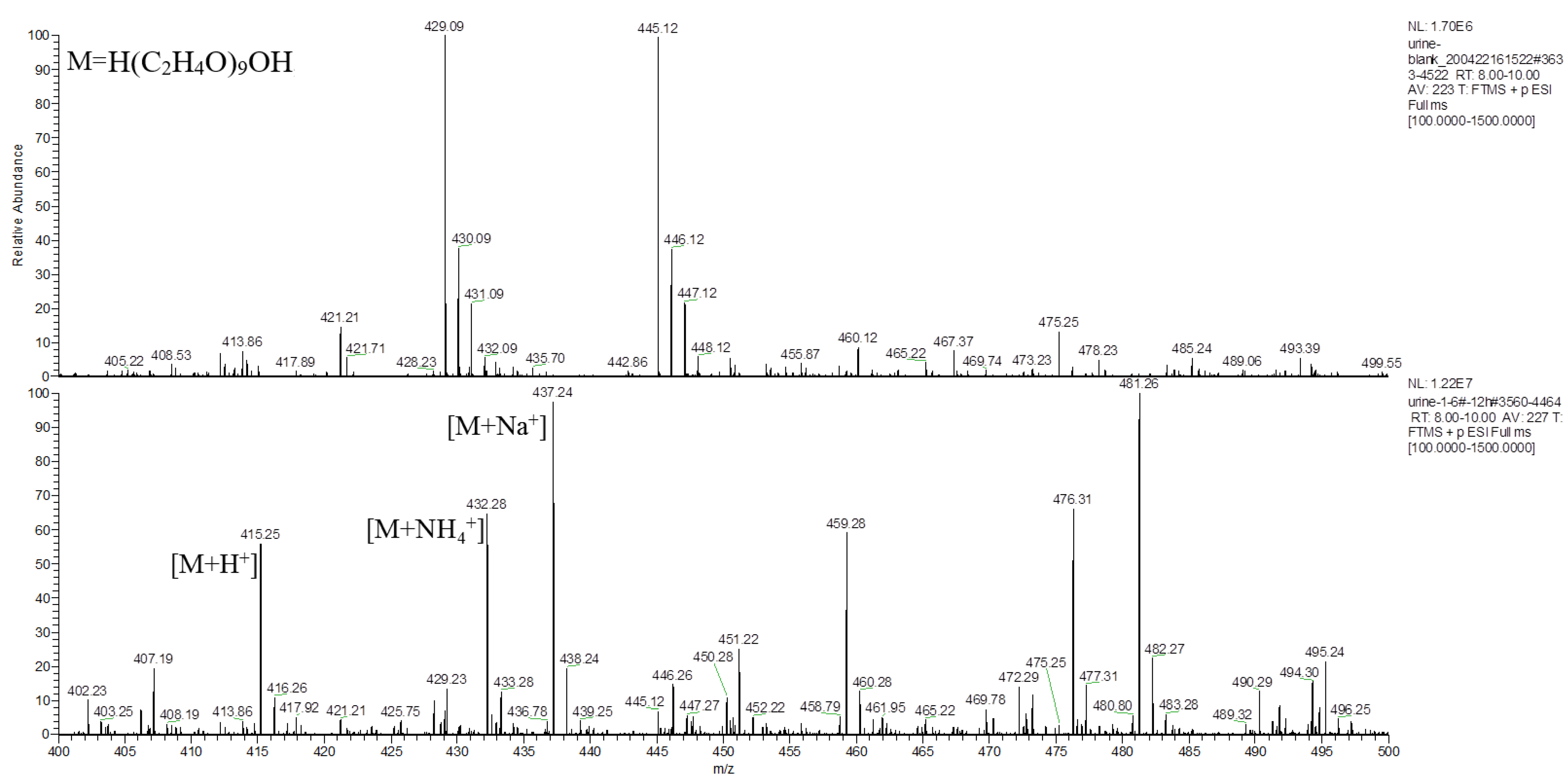
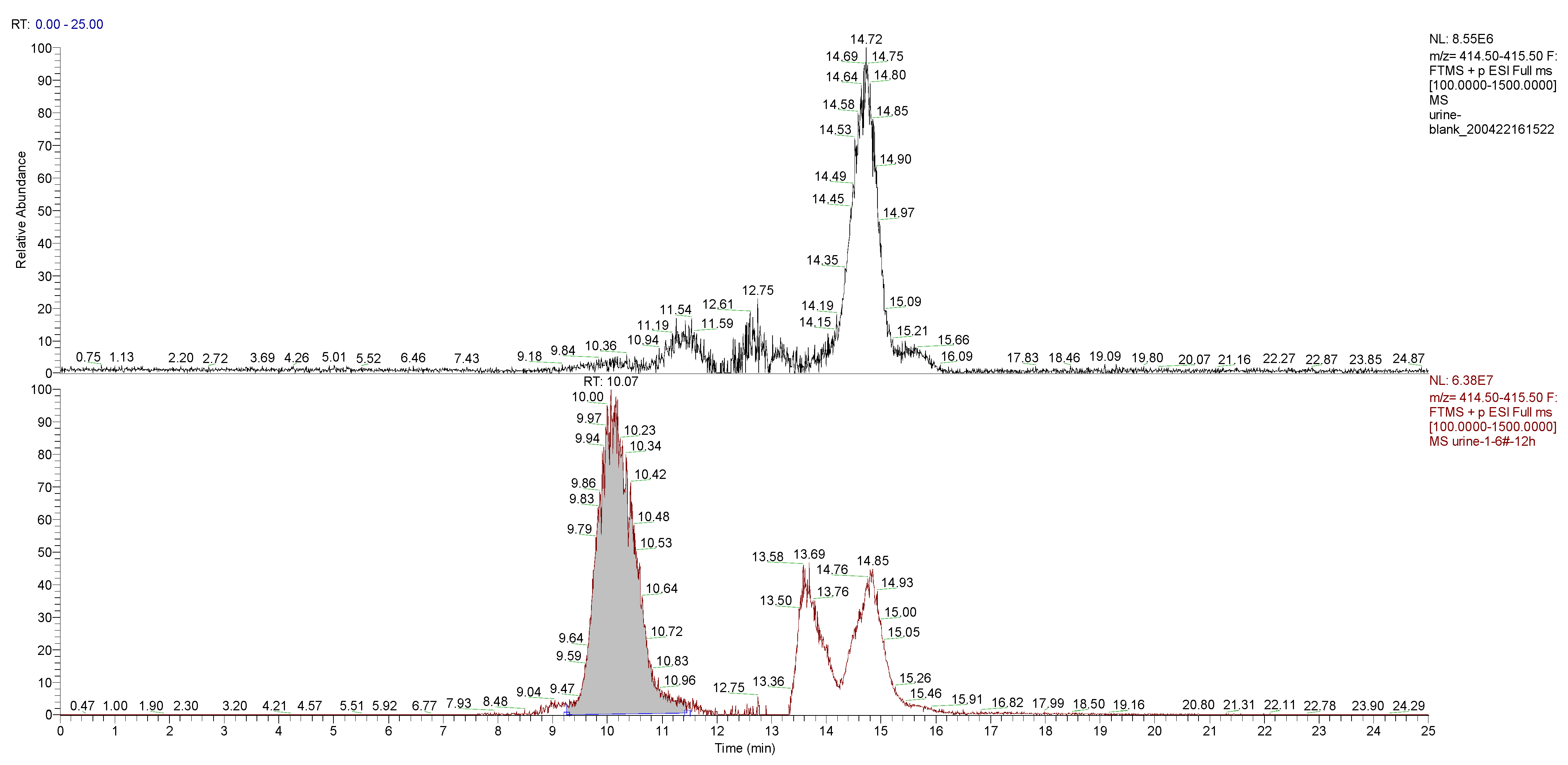
| No. | CTetra-PEG-SS (mol∙L−1) | Molar Ratio (Tetra-PEG-SS/TLYS) | CBuffer (mol∙L−1) | pH | Gelation Time (s) | Swelling Ratio | Degradation Time (h) |
|---|---|---|---|---|---|---|---|
| 1 | 0.01 | 2:1 | 0.05 | 7.4 | 150 ± 6 | 4.01 ± 0.15 | 17 ± 1 |
| 2 | 0.01 | 1:1 | 0.05 | 7.4 | 34 ± 4 | 3.26 ± 0.11 | 40 ± 2 |
| 3 | 0.01 | 3:4 | 0.05 | 7.4 | 19 ± 2 | 1.92 ± 0.08 | 48 ± 2 |
| 4 | 0.01 | 1:2 | 0.05 | 7.4 | 44 ± 3 | 2.45 ± 0.12 | 32 ± 0 |
| 5 | 0.01 | 1:3 | 0.05 | 7.4 | 80 ± 4 | 5.96 ± 0.08 | 17 ± 1 |
| 6 | 0.01 | 1:1 | 0.1 | 7.4 | 16 ± 2 | 1.86 ± 0.05 | 48 ± 2 |
| 7 | 0.01 | 1:1 | 0.2 | 7.4 | 28 ± 2 | 1.89 ± 0.04 | 48 ± 2 |
| 8 | 0.01 | 1:1 | 0.3 | 7.4 | 24 ± 2 | 1.93 ± 0.12 | 48 ± 2 |
| 9 | 0.005 | 1:1 | 0.1 | 7.4 | 38 ± 3 | 2.03 ± 0.12 | 48 ± 4 |
| 10 | 0.002 | 1:1 | 0.1 | 7.4 | 47 ± 2 | 1.96 ± 0.04 | 48 ± 2 |
| 11 | 0.01 | 1:1 | 0.1 | 6.8 | 248 ± 15 | 2.05 ± 0.08 | 48 ± 2 |
| 12 | 0.01 | 1:1 | 0.1 | 7.8 | 15 ± 2 | 1.91 ± 0.11 | 48 ± 2 |
| 13 | 0.01 | 1:1 | 0.1 | 9.0 | 12 ± 2 | 1.88 ± 0.05 | 48 ± 2 |
| Day | Blood Recovery Concentration (10−4∙g−1) | |
|---|---|---|
| 3H | 14C | |
| 0.083 | 14.66 ± 2.833 | 15.06 ± 3.586 |
| 0.167 | 10.99 ± 5.184 | 13.75 ± 7.236 |
| 0.333 | 11.09 ± 2.509 | 11.96 ± 3.399 |
| 0.5 | 8.94 ± 2.952 | 9.41 ± 3.199 |
| 1 | 3.673 ± 0.555 | 3.006 ± 0.420 |
| 2 | 2.338 ± 0.535 | 1.283 ± 0.270 |
| 3 | 2.384 ± 1.009 | 1.063 ± 0.260 |
| 4 | 2.262 ± 0.562 | 0.943 ± 0.316 |
| 5 | 1.866 ± 0.547 | 0.681 ± 0.165 |
| 6 | 1.746 ± 0.678 | 0.508 ± 0.244 |
| 7 | 1.842 ± 0.595 | 0.781 ± 0.151 |
| 9 | 1.583 ± 0.507 | 0.593 ± 0.177 |
| 10 | 1.376 ± 0.503 | 0.470 ± 0.160 |
| Tissues | 14C | 3H | ||||
|---|---|---|---|---|---|---|
| Cmax (10−4∙g−1) | AUC0–10d (10−4/g∙d) | Tmax (d) | Cmax (10−4∙g−1) | AUC0–10d (10−4/g∙d) | Tmax (d) | |
| Jejunal Contents | 222.9 ± 58.37 | 164.5 ± 61.40 | 0.2733 ± 0.0878 | 141.7 ± 99.7 | 104.0 ± 29.90 | 0.3017 ± 0.0694 |
| Jejunal | 86.1 ± 98.3 | 61.98 ± 26.87 | 0.1883 ± 0.0694 | 78.08 ± 99.5 | 88.5 ± 19.27 | 0.2167 ± 0.1388 |
| Fat | 46.23 ± 61.13 | 54.37 ± 42.20 | 1.942 ± 3.951 | 35.15 ± 48.08 | 45.30 ± 17.49 | 0.3583 ± 0.1280 |
| Muscle | 11.74 ± 8.46 | 24.28 ± 6.064 | 0.2450 ± 0.0931 | 11.15 ± 5.817 | 43.12 ± 6.663 | 0.2167 ± 0.0878 |
| Sexual gland | 52.09 ± 56.00 | 63.30 ± 50.88 | 0.2167 ± 0.1388 | 39.64 ± 49.25 | 95.0 ± 54.14 | 0.2167 ± 0.0878 |
| Kidney | 205.8 ± 138.9 | 219.7 ± 37.77 | 0.2450 ± 0.0931 | 284.3 ± 85.7 | 589.4 ± 70.01 | 0.2450 ± 0.0931 |
| Spleen | 51.56 ± 63.56 | 60.35 ± 11.05 | 0.2167 ± 0.1388 | 57.53 ± 54.43 | 142.2 ± 47.87 | 0.2450 ± 0.1422 |
| Liver | 24.10 ± 5.620 | 59.00 ± 15.12 | 0.2167 ± 0.1388 | 28.43 ± 3.861 | 73.94 ± 11.97 | 0.1883 ± 0.0694 |
| Lungs | 20.39 ± 5.202 | 35.04 ± 10.03 | 0.2733 ± 0.1388 | 18.71 ± 2.187 | 77.58 ± 17.17 | 0.3017 ± 0.1671 |
| Heart | 14.48 ± 3.938 | 30.94 ± 13.45 | 0.2167 ± 0.0878 | 13.77 ± 1.645 | 64.57 ± 13.98 | 0.7183 ± 1.121 |
| Thymus | 24.86 ± 8.96 | 79.61 ± 62.25 | 1.913 ± 3.964 | 22.97 ± 3.781 | 88.6 ± 18.45 | 0.3300 ± 0.1075 |
| Brain | 12.17 ± 5.805 | 42.66 ± 35.95 | 1.885 ± 3.978 | 5.611 ± 1.881 | 34.22 ± 9.35 | 0.8017 ± 1.125 |
| Blood | 17.64 ± 5.353 | 17.79 ± 4.014 | 0.2733 ± 0.1388 | 16.31 ± 3.191 | 26.96 ± 3.916 | 0.2733 ± 0.1388 |
Publisher’s Note: MDPI stays neutral with regard to jurisdictional claims in published maps and institutional affiliations. |
© 2022 by the authors. Licensee MDPI, Basel, Switzerland. This article is an open access article distributed under the terms and conditions of the Creative Commons Attribution (CC BY) license (https://creativecommons.org/licenses/by/4.0/).
Share and Cite
Zuo, B.; Cao, M.; Tao, X.; Xu, X.; Leng, H.; Cui, Y.; Bi, K. Metabolic Study of Tetra-PEG-Based Hydrogel after Pelvic Implantation in Rats. Molecules 2022, 27, 5993. https://doi.org/10.3390/molecules27185993
Zuo B, Cao M, Tao X, Xu X, Leng H, Cui Y, Bi K. Metabolic Study of Tetra-PEG-Based Hydrogel after Pelvic Implantation in Rats. Molecules. 2022; 27(18):5993. https://doi.org/10.3390/molecules27185993
Chicago/Turabian StyleZuo, Baoyan, Mingxue Cao, Xiumei Tao, Xiaoyu Xu, Hongfei Leng, Yali Cui, and Kaishun Bi. 2022. "Metabolic Study of Tetra-PEG-Based Hydrogel after Pelvic Implantation in Rats" Molecules 27, no. 18: 5993. https://doi.org/10.3390/molecules27185993
APA StyleZuo, B., Cao, M., Tao, X., Xu, X., Leng, H., Cui, Y., & Bi, K. (2022). Metabolic Study of Tetra-PEG-Based Hydrogel after Pelvic Implantation in Rats. Molecules, 27(18), 5993. https://doi.org/10.3390/molecules27185993





